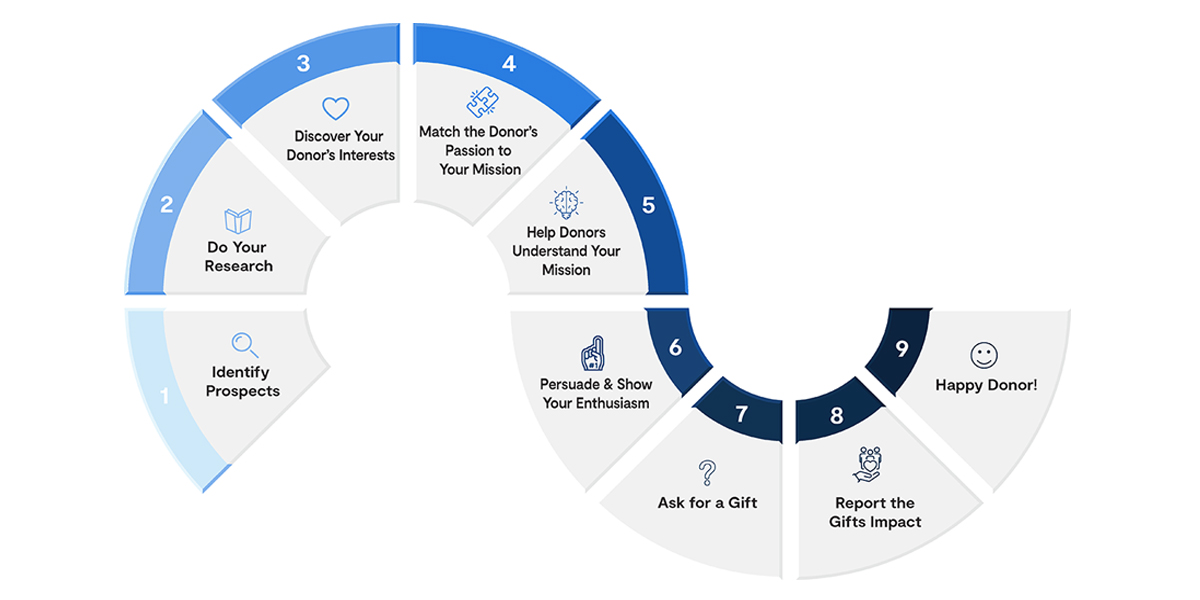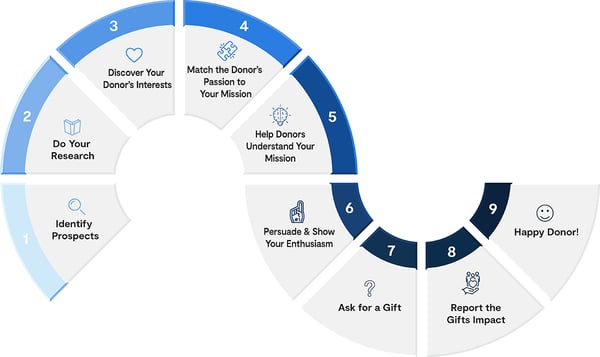Is Fundraising Something That Happens Over There?
So, tell me, what is that you do in your department? That phrase, spoken with a bit (or a lot) of...
Scroll Down

The development office at the Denver Art Museum is calm. With the first quarter nearly complete, rising transportation costs, two new exhibits on the walls, and a volatile stock market, staff could be sweating over missed benchmarks and donors needing affirmation of their gift's impact. There’s no evidence of panic in this office because the Museum’s Chief Development Officer, Arpie Chucovich, has been rolling up her sleeves to support the Museum’s mission for 13 years. Donor by donor, she led a $175 million campaign to renovate, expand, and reopen the Martin Building in 2021.
Ms. Chucovich and her staff are professional fundraisers. Chiara Robinson, Director of Institutional Giving, has been raising funds for 16 years, and Mary Beth Polce, Associate Director of Development, has impacted giving at the Museum for 8 years. They have a voice with Museum leadership and the board and are supported. Their tenure has allowed them to build meaningful donor relationships, instill a donor-centric approach, and create trust throughout the Museum.

As the above demonstrates, retention and support of experienced fundraisers is essential to an organization’s fundraising success. However, as Ben Casselman reported in a December 2021 report in the New York Times, non-profits are experiencing labor shortages.
Non-profits saw a 4.8% decline from pre-pandemic levels compared to for-profit’s 1.5% decline. Many fundraisers who were furloughed during COVID-19 decided to leave. Others suffered burnout, or they found a for-profit position with better support. With revenues lagging, leaders have asked staff to do more without increased pay and resources. The decrease in non-profit employment points to the risk that “people who leave the field in search of better pay and support could be unlikely to return.”
With significant onboarding costs and the unreal expectation that a September hire can impact end-of-year giving, organizations need to address donor-centric culture, support, and salaries before losing veteran fundraisers. The costs are high when an experienced fundraiser quits. They leave a breach of trust with donors, create a knowledge gap, and it often results in a revenue shortfall.
Fundraisers are not office managers, receptionists, nor errand runners, or web designers.
Fundraisers are not event planners. Table arrangements, catering, and invitation design take away from true donor engagement. Silent auctions are silent, and they don’t build meaningful relationships. Events, especially during the pandemic, proved to be less productive than direct donor contacts. A study by Salesforce reported that more revenue resulted from individual contributions and major gifts than speculative fundraising events.
Fundraisers are not magicians. They don’t perform wizardry in transactional environments with unrealistic goals and pressure.
Provide professional development to your fundraising staff, board, and organizational leadership. AFP, CASE, and a host of other organizations offer certifications and in-depth training for all levels of fundraising.
Boards and organizational leaders need to listen to and partner with fundraising teams to build a culture of philanthropy, collaborate on goals, develop realistic expectations, and empower staff to strategize and dissolve obstacles.
Fundraising teams need resources to be successful. The old adage, “It takes money to raise money,” is an absolute.
In the November survey by Salesforce of fundraisers and CEOs in an alliance of 21 large non-profits in the USA, 50% blamed burnout for leaving their job, and 40% percent of all respondents listed employee retention as a major issue. When fundraisers collapse mid-mission, the ripple spreads throughout the organization.
Ms. Polce shared that the Museum’s development office lost entry-level workers often assigned task-oriented work that was “perhaps less fulfilling for individuals interested in the relationship-building aspects” of fundraising.
The Denver Art Museum designates funds for professional development. Staff participates in conferences and local workshops. In 2018, Ms. Chucovich led the annual AMDA conference, and the Denver Art Museum will host the AAM in 2023. This kind of collaborative work with other fundraising professionals provides a crucial platform for intentional conversations and sharing of new ideas.
If fundraisers are not feeling valued and heard, then how can they influence a donor-centric culture?
Do boards support CEOS to shape their development office?
How do boards and organizational leadership acknowledge the professionalism of fundraisers? Do they listen without trying to take over to fix the issues or push for obsolete and ineffective fundraising strategies?
Does leadership drive a dollar-first view of philanthropy?
According to Philanthropy Daily, why do development directors last an average of 18 months?
Successful organizations depend on informed strategies to engage donors, a well-managed database to track donor behavior, resources to train staff and volunteers, a strong culture of philanthropy, technology to assist in major giving donor identification and relationship building, and reasonable goals and expectations for development staff and new hires.

Fundraisers at the Denver Art Museum formed a Campaign Committee with Board members interested in giving or opening doors in their networks. They discuss specific prospects and the strategies of each ask with the board. Ms. Chucovich wrote that Museum’s board members “know and understand the time it takes to develop relationships with donors” because of direct participation and engagement.” Ms. Polce added that staff is empowered to “develop deep and longstanding relationships with our committed patrons,” that “lead to expanded support.”
The work to retain professional fundraising staff is tied to donor retention. Veteran staff are skilled in conducting discovery meetings with donors, following up to determine the donor’s commitment to the organization, developing a culture of philanthropy, and knowing when to ask for a gift.
Persistence and consistent personal contact by the same fundraiser elicit trust that may take years to build.
Donors’ concerns and values need to be heard and acknowledged with timely feedback on the impact of their gifts.
Authentic engagement, nuanced conversations, and meetings with donors have more to do with grandchildren than a check. Expert fundraisers uncover shifts in donors’ lives.
Relationship building and active listening build lasting partnerships.
Ashley Thompson, Managing Director of the Blackbaud Institute, is quoted as, “The appetite for giving is not waning, and savvy organizations now recognize the opportunity to shift from an episodic mindset to one of continuous engagement and stewardship.”
Organizational leaders that support and collaborate with fundraisers create fulfilling partnerships, drive strategic initiatives, and build long-term sustainability. Time, listening, and patience are necessary to build trust with donors and understand a donor’s interest in making an impact. Board members and committed CEOs who take the time to listen to experienced fundraisers and give them a voice, follow fundraising best practices, provide the resources for the work, and demonstrate patience with donor engagement will help the team become great fundraisers, and the organization will thrive. Investing in fundraising staff IS investing in your organization’s mission.
Is fundraising sufficiently supported at your organization? Please let us know your thoughts!
So, tell me, what is that you do in your department? That phrase, spoken with a bit (or a lot) of...
So, tell me, what is that you do in your department? That phrase, spoken with a bit (or a lot) of...
We are going to get technical for this article. Are you ready!?!